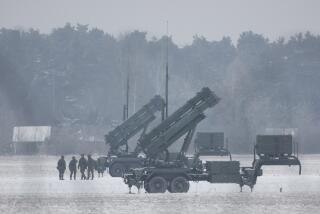Services Hoard $30 Billion in Surplus Items
- Share via
WASHINGTON — America’s armed services have $30 billion worth of unneeded military supplies and hardware gathering dust in warehouses across the country or rusting away outside, according to a report released Sunday by the Senate Budget Committee.
Despite those stockpiles, the Pentagon had $20 billion worth of new orders in the pipeline and another $30 billion waiting to be spent on supplies and equipment, according to the committee study, carried out in the closing months of 1989.
The findings, gleaned from previous reports by the General Accounting Office and military auditors, interviews with Defense Department officials and inspections by staff aides for Budget Committee Democrats, were sent to Defense Secretary Dick Cheney on Friday.
Cheney is scheduled to appear before the panel today to discuss the Bush Administration’s proposed $295-billion defense budget for 1991. Committee Chairman Jim Sasser (D-Tenn.) said he intends to use the report to raise questions about potential budget cuts.
In conversations with officials as recently as last week, Sasser said, committee investigators were told that the Army alone has 12,000 categories of items in oversupply.
“What we have,” Sasser said in an interview Sunday, “is a disinclination to ever terminate contracts. Once they are signed, they go on and on. There are no incentives among purchasing people to save money.”
During the last five years, the report said, the Pentagon has spent about $700 million to refurbish and expand its warehouse space.
But the committee staff found that military warehouses and depots across the country were “glutted” and that expensive hardware sometimes was stored in the open, deteriorating from exposure to the elements.
For example, parts for Apache helicopters were found stored outside because of a lack of available warehouse space and had to be extensively overhauled before use, investigators reported. In some cases, the parts were unsalvageable.
They reported that in Oakland, ship propellers have been stored on docks because there is no space to store them inside.
With the Administration planning to bring home thousands of American troops from Europe and congressional Democrats pushing for even greater troop reductions, Sasser said the surplus supply problems are apt to be compounded.
In a letter to Cheney, Sasser called on the Pentagon to halt the purchase of items already on hand and to develop plans for disposal of unneeded items. He also asked for another review of the military’s requirements for additional warehouse construction.
Altogether, the armed forces’ inventory of stored supplies and equipment amounts to more than $100 billion, of which an estimated $30 billion is unneeded, the report said.
Between 1983 and 1988, during the Ronald Reagan Administration’s military buildup, the inventory soared to $103 billion from $61 billion, the committee staff found.
“The largest rate of growth . . . has been in ‘inapplicable inventory’ items (that) the Pentagon says it doesn’t need and may never need,” the report said.
In the most extreme case cited in the report, investigators said they turned up what amounted to a 13,157-year supply of a machine tool used to make circuits for the Navy’s F-14 Tomcat fighter plane. According to the report, only four of the tools are used each year, but the Navy has 52,628 of them in stock.
The Army was found to have purchased 126 different sizes of shirts for female soldiers, many of which are never expected to be worn.
The oversupply and the stocking of items of dubious use was blamed on poor management and inventory control practices. In some cases, those practices made it difficult to determine what was already in warehouses.
Investigators said that military agencies continued to buy items after they already had been identified as unneeded. The report cited a GAO finding last year that the Pentagon had on hand a more-than-50-year supply of 1,241 items, and a 25-to-50-year supply of another 852 items. The two categories together represented a value of more than $100 million.
The warehouse crunch has led to even more mistakes in acquisition, according to the report.
The committee staff cited one unidentified Army item, which was found to have been stored at 27 locations in California. In another case last year, the Army reported 80,000 jungle camouflage helmet covers as lost, purchased more, then found the missing 80,000.
Some armed forces supply and warehousing operations are still using “old-fashioned pencil and paper” inventory control and management practices, Sasser said.
More to Read
Sign up for Essential California
The most important California stories and recommendations in your inbox every morning.
You may occasionally receive promotional content from the Los Angeles Times.













